In the past two years, more than a dozen states nationwide have passed robust K–12 choice policies, both as a part of their COVID-19 education recovery strategies and to give parents the freedom to choose the learning environments that align with their values and work best for their children.
Texas, however, is not among them. In Texas, the economy is racing ahead full speed, while state K–12 education has stalled.
One major obstacle has been the claim by opponents of school choice in Texas that giving families more education options via education choice policies would harm or even destroy rural district schools. These concerns, even if understandable, are not based on evidence. An assessment of the available evidence shows that both rural students and teachers have a great deal to gain from education choice. In fact, choice is exactly the upgrade required to get Texas’s rural education engine running strong.
Expanding the “Texas Miracle” to K–12 Education
Drawn by the opportunities of a booming economy, citizens are flocking to be a part of “the Texas miracle.” Between July 2021 and July 2022, Texas saw a net increase of 350,000 residents through migration, second only to Florida at 444,000.REF The private Texas economy is wildly successful.
The Texas public school system, on the other hand, shows worrisome signs of decline. Standardized test scores range from stagnant to falling, with some of the worst declines in rural Texas. Ironically, rural Texas public school officials have been at the forefront of resisting a key measure necessary to spur an education renaissance—namely, education choice. Opponents of education choice in Texas routinely cite the desire to preserve rural school districts as their driving motivation.REF However, the sharp decline in the quality of education in rural Texas shows that what it needs is not preservation of the status quo but significant reform.
Texas families recognize the need for reform. Last fall, a survey by The Dallas Morning News and the University of Texas at Tyler found that 60 percent of Texans support school choice policies. Support was even higher among Latino respondents (65 percent). School choice also garnered majority support from Democrats and Independents (53 percent each) and especially Republicans (70 percent).REF
Support for choice policies is particularly strong among rural Republicans in Texas. In the March 2022 Texas Republican primary, Proposition 9 asked voters whether “Texas parents and guardians should have the right to select schools, whether public or private, for their children, and the funding should follow the student.”REF Voters answered in the affirmative by a margin of 88 percent to 12 percent. Some of the highest levels of support came from the most rural counties in Texas, including Culberson (97 percent), Edwards (89 percent), Kent (87 percent), McMullen (90 percent), Kenedy (100 percent), Roberts (87 percent), and Terrell (90 percent).
Texans want their education system to look more like their economy. The economy is flourishing in Texas because policymakers embraced free-market policies that have provided fertile ground for innovation and entrepreneurship. The Texas education system is in a state of stagnation and decline for the opposite reason—a lack of choice and competition.
It need not be that way. Other states have had education choice policies for decades. The evidence from Arizona—the state with the most robust education choice environment in the nation—is clear: Rural district schools have significantly improved academic achievement during the choice era.REF Since 1994, K–12 education options in rural Arizona have massively increased, and—contrary to the predictions of choice critics—all the districts remain in operation and the state-level and national data demonstrate improved academic achievement for students in rural areas.
Rural Texans have nothing to lose and much to gain from education choice. The evidence demonstrates that rural Texas students and educators will not merely survive choice, they will thrive with it.
The Decline of Rural Education in Texas
Texas rural education went into an academic decline before the COVID-19 pandemic, and matters worsened further afterwards. The National Assessment of Educational Progress (NAEP), known as the Nation’s Report Card, collects academic testing data on random samples of students in all 50 states, with fourth-grade and eighth-grade mathematics, reading, and science representing the most frequently tested subjects with state-level results. Breakdowns for rural students by state have been available since the 2007 NAEP math and reading exams. The data presented for science are pre-pandemic only as they cover the longest period with state-level data available from 2009 to 2015.
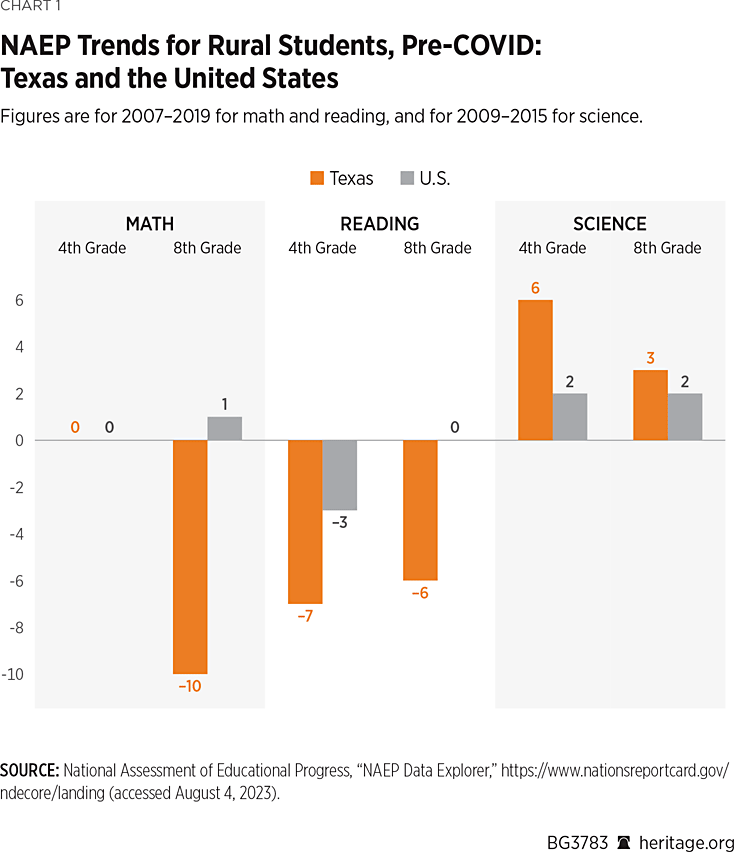
On the math and reading NAEP exams, 10 points approximately represents a grade level worth of progress (thus one would expect a group of fifth-graders to score 10 points higher than a similar group of fourth-graders). The science NAEP exams use a different scale. Chart 1 shows trends for rural students both nationally and in Texas for the longest pre-pandemic period available—from 2007 to 2019.
Between 2007 and 2019, rural students nationwide demonstrated a flat-to-declining trajectory on academic achievement. In Texas, the news was much worse in math and reading. Rural students in Texas saw a 10-point decline in eighth-grade math, a seven-point decline in fourth-grade reading, and a six-point decline in eighth-grade reading.
The post-pandemic results were even worse. In 2022, the NAEP released fourth-grade and eighth-grade math and reading results—the first state-level results since the COVID-19 pandemic. The overall results nationwide were very troubling. The NAEP has not yet provided post-pandemic science results at the state level. The math and reading results for students living in rural Texas areas were nothing short of catastrophic.
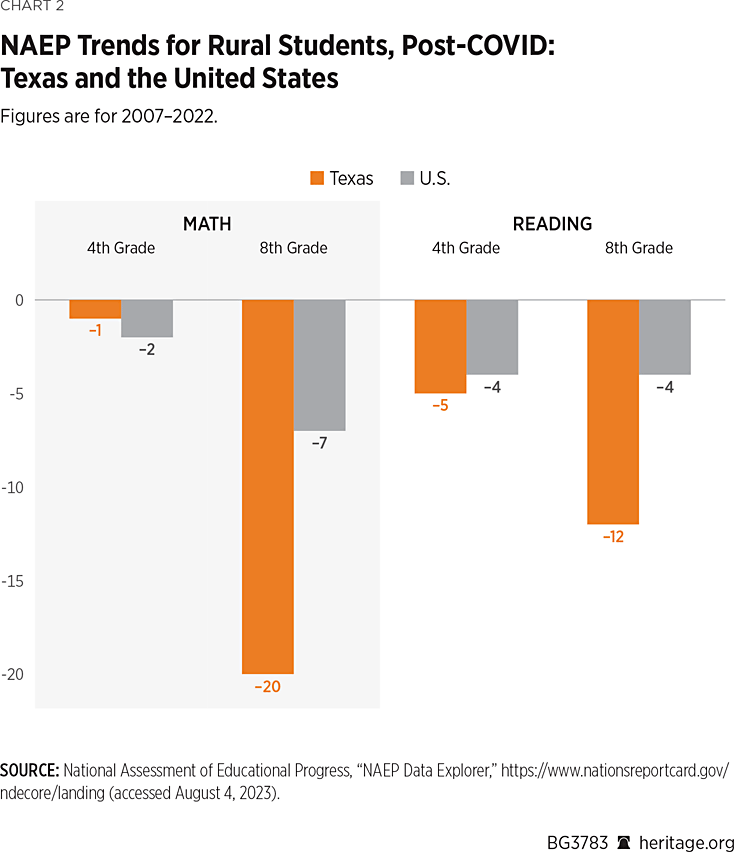
Rural students in Texas saw declines approximately three times larger than the national average for their peers in both eighth-grade math and eighth-grade reading. As shown in Chart 2, eighth-grade reading scores fell by 12 points since 2007, and eighth-grade math scores fell by 20 points—the equivalent of two grade levels’ worth of learning. Rural students nationwide are falling behind, but they are still far outpacing rural students in Texas.
Opponents of education choice might claim that the introduction of education choice policies might make the dire situation in rural schools in Texas even worse. To evaluate that hypothesis, this Backgrounder provides an examination of the record for rural education outcomes in the state which has had by far both the most robust education choice environment both statewide and for rural areas for the longest period.
K–12 Education in Arizona and Texas
Both Arizona and Texas are border states with large and growing metropolitan areas as well as vast rural areas. But the trajectories of their K–12 education systems have been diametrically opposed.
Arizona not only has the most robust K–12 choice environment in the nation, but it also has had the most K–12 choice options, both public and private, in rural areas—with no close rival among the remaining states. Even states with relatively large private choice programs, such as Florida and Indiana, have charter school sectors with a significantly smaller presence in rural communities than Arizona. Ohio and Wisconsin also have long-standing choice private choice programs, but these have primarily focused on urban areas, as have their charter school sectors.
Other states will be closing the gap with Arizona as several passed universal private choice programs during the 2022 and 2023 legislative sessions, but these programs will be growing incrementally over time. Arizona lawmakers have been expanding choice in every way possible since 1994.
Arizona experienced a rapid rate of K–12 student enrollment growth between World War II until the advent of the Great Recession in 2008, with more moderate enrollment growth since. Like Texas, Arizona shares a border with Mexico and has seen a substantial rise in Hispanic students. Arizona also educates the nation’s second-largest Native American student population after Oklahoma. And, like Texas, Arizona’s K–12 population transitioned from being majority white to majority “minority” in 2003.REF
A large majority of Arizona students live in the Phoenix and Tucson metropolitan areas, but the state has dozens of rural school districts, including some unique rural schools. Many other rural Arizona districts are more typical of small-town communities found in Texas and around the nation.
But the similarities end there. Unlike in Texas, Arizona’s performance on NAEP exams has significantly improved over time with multiple major student groups showing substantial improvement.
Arizona’s improved K–12 performance is not due to higher levels of spending. Indeed, Arizona’s per-pupil spending is on the lower end nationally. U.S. Census Bureau data show that Texas district schools spend, on average, 14 percent more per pupil than schools in Arizona.REF Arizonans are doing more with less.
During the 1990s, Arizona was a lower-income state struggling to build public schools fast enough to keep up with the growing student population. Arizona experienced the nation’s second-largest K–12 school enrollment growth between 1990 and 2023 at 77.5 percent, second only to Nevada.REF Challenged by relentless enrollment growth and plagued by low levels of academic achievement, Arizona lawmakers embraced school choice policies both to relieve pressure on the state’s K–12 infrastructure and to induce pressure to improve academic performance.
Public School Choice: Charter Schools and Inter-District Choice. In 1994, Arizona adopted the nation’s most robust state charter school policy as well as a statewide district open-enrollment policy. Both policies included provisions intended to spur the expansion of education options. For example, Arizona pioneered the creation of a statewide charter school authorization board, which made it much easier to open charter schools in Arizona than in states where local school districts can veto the creation of schools that they view as their competitors. Likewise, Arizona’s open-enrollment statute required districts to have an open-enrollment policy and disallowed districts from charging tuition to families transferring from other districts.
The policies worked. Arizona now has one of the nation’s highest proportions of K–12 students attending charter schools (about 22 percent of public school students) and a vigorous system of district open-enrollment that even outnumbers charter school students in the Phoenix metro area.REF A 2017 analysis of the Phoenix area found that approximately half of students attended either charter schools (16 percent) or district schools outside their resident zone (30 percent).REF When including students attending private schools and home schools, a majority of Phoenix-area students attend a school other than their zoned district school.
District schools both lose and gain students due to open enrollment and other forms of choice, creating a competitive environment.
Private School Choice: Tax-Credit Scholarships and Education Savings Accounts. Arizona lawmakers did not stop at charter schools and open enrollment. In 1997, Arizona enacted the nation’s first tax-credit scholarship policy. Under this policy, taxpayers could donate to a nonprofit school tuition organization and receive a dollar-for-dollar credit against their state income tax. Arizona lawmakers subsequently expanded this program several times. Thousands of rural students attend private schools using tax-credit scholarships.
In 2011, Arizona lawmakers created the nation’s first K–12 education savings account (ESA) policy, known locally as the Empowerment Scholarship Accounts. With an ESA, parents of participating K–12 students can receive 90 percent of the public funds that the state would have spent on their child in the public system. Families can use the ESA funds for a wide variety of educational goods and services, including private school tuition, tutoring, textbooks, online courses, special-needs therapy, college courses, and more. Arizona lawmakers expanded student eligibility several times before Arizona Governor Doug Ducey signed a bill into law in 2022 expanding eligibility to all K–2 students.
As of 2022, about 7 percent of Arizona students use tax-credit scholarships or ESAs to pay for private learning options.REF
The Rise of Microschools in Arizona. Before the pandemic, Arizona saw a flourishing of microschooling.REF There is no universally agreed-upon definition of a “microschool,” but generally speaking, microschools are small clusters of families that pool resources and collaborate to educate their children.REF They usually have an in-person instructor who teaches about five to 15 students, although some self-declared microschools enroll as many as 150 students.REF Arizona microschools include schools run by Arizona State University Prep, Acton Academy, Adamo Education, Great Hearts, Kai Pods, and Prenda.
Crucially, these and other rural Arizona choice schools are the result of bottom-up efforts of teachers and families. Arizona’s rural teachers and families have proven themselves every bit as capable of creating high-demand schools as their peers in urban areas.
Microschools represent a 21st-century reimagining of the one-room schoolhouse—simultaneously innovative and yet deeply rooted in the nation’s history and culture. Larger schools replaced the original one-room schoolhouses because they could not offer the same depth or breadth of study. But now, with the assistance of technology, microschools can offer a comprehensive and rigorous education while providing a level of individual attention and personalization that larger schools struggle to achieve. Some Arizona microschools have been financed through the charter school mechanism and others through the ESA program.
Arizona’s Education Choice Environment Is a Model for Other States. “Our constitution does not copy the laws of neighboring states,” the Athenian leader Pericles told mourners at a funeral ceremony for soldiers lost early in the Peloponnesian War. “We are rather a pattern to others than imitators ourselves.”REF When it comes to expanding choice opportunities for students and teachers, Arizonans can likewise make this boast: Dozens of states have followed Arizona’s lead in adopting tax-credit scholarship and ESA policies. And although Arizona did not invent charter schools or district open enrollment, it has been the most enthusiastic adopter of both forms of school choice.
Arizona’s education choice environment has also been robust in rural areas. For example, in 2015, the Brookings Institution published a map including a calculation of the percentage of students in each state that have access to one or more charter schools operating in their zip code. Indeed, the Brookings measure likely underestimated the impact of charter schools in Arizona, as many Arizona zip codes have multiple charter schools. Nevertheless, Arizona easily ranked as the state with the most inclusive charter school sector in the Brookings measure, with 84 percent of students statewide living in a zip code with one or more charter schools.
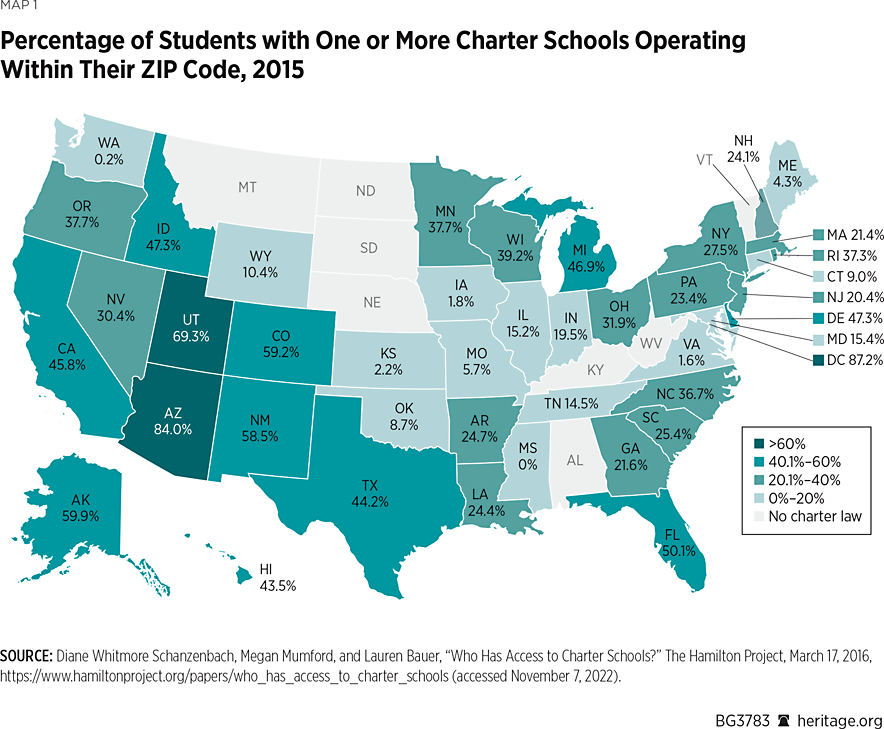
Charter school access is broadly available across community types in Arizona, and the states following Arizona in this ranking (Utah, Alaska, and Colorado, respectively) lacked broad private choice programs between 2007 and 2022. As shown in Table 1, Arizona has more charter schools in rural areas (64) than the total number of charter schools statewide in 13 other states with charter school laws (Alabama, Alaska, Arkansas, Connecticut, Delaware, Iowa, Kansas, Kentucky, Mississippi, New Hampshire, Rhode Island, Washington, and Wyoming). Even though rural Texas is much larger and more populous than rural Arizona, with a much larger rural student population (1.1 million K–12 students in Arizona versus 5.4 million in Texas), Arizona has one more rural charter school than Texas. Arizona has seven rural counties whereas Texas has 191 rural counties. A rural student in Arizona is thus far more likely to have access to a charter school than a rural student in Texas.
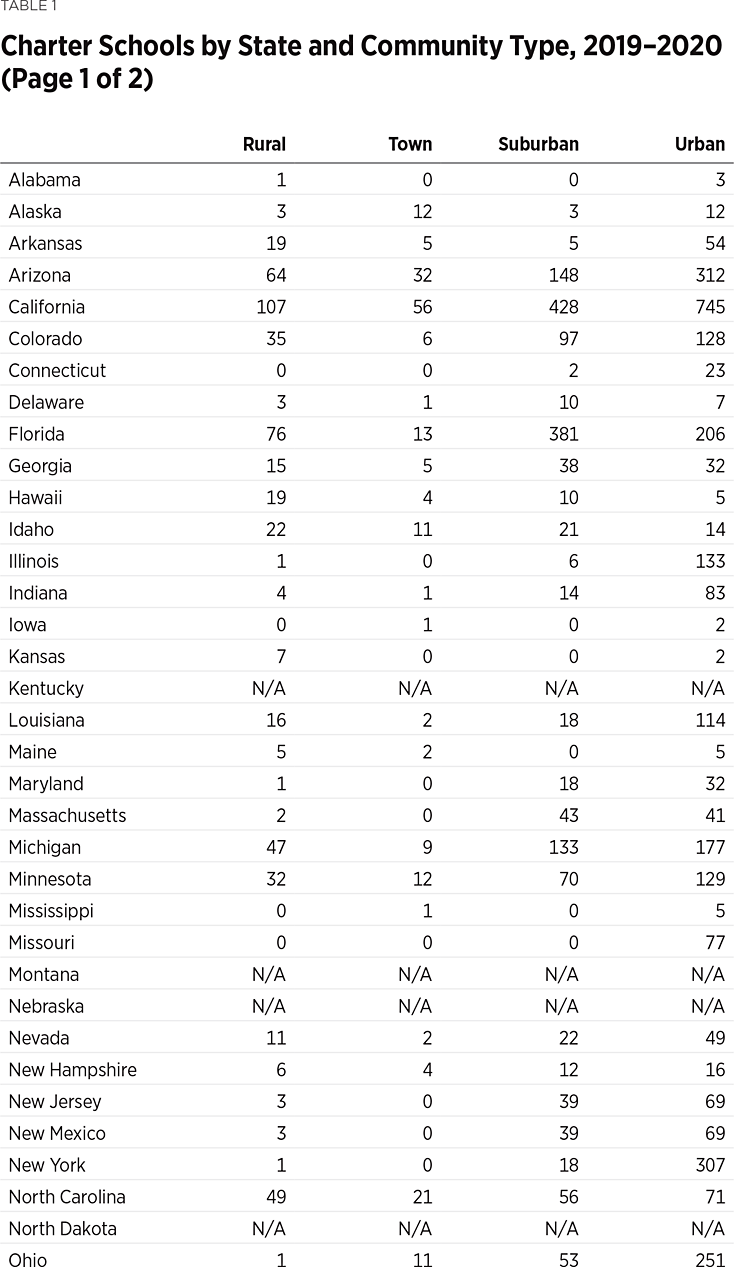
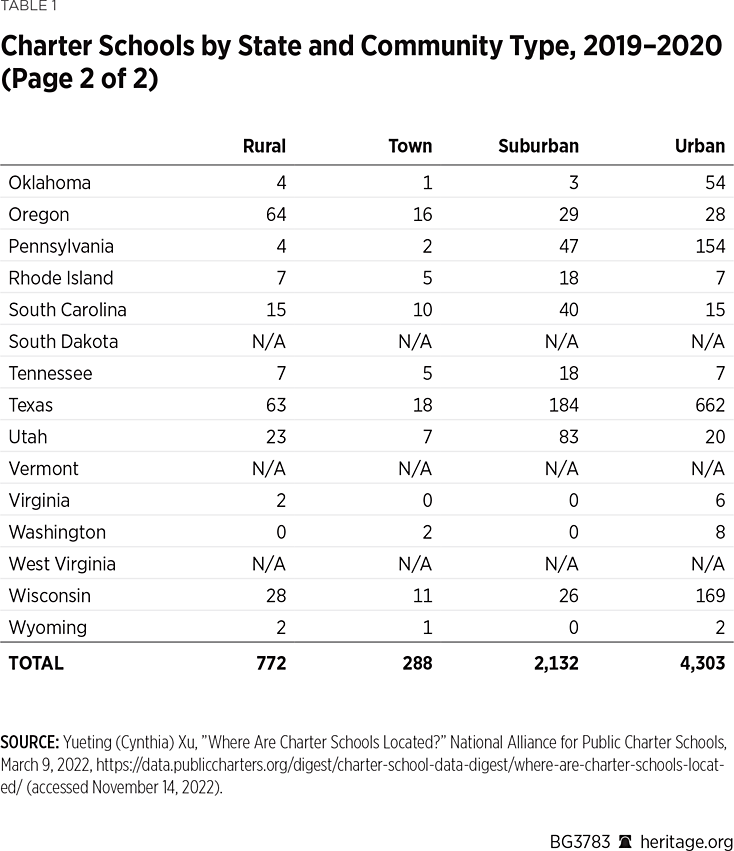
The federal Office of Rural Health Policy classifies seven Arizona counties as rural, the five largest of which have private schools.REF Over the past decade, the number of scholarships awarded in these rural counties more than doubled. As shown in Table 2, the number of tax-credit scholarships awarded in these rural counties grew by 163 percent since the 2010–2011 academic year. This tracks with the available private school enrollment data. As shown in Table 3, student enrollment in private schools doubled over the past eight years in the four rural counties for which data were available for both the 2021–2022 and 2013–2014 academic years.
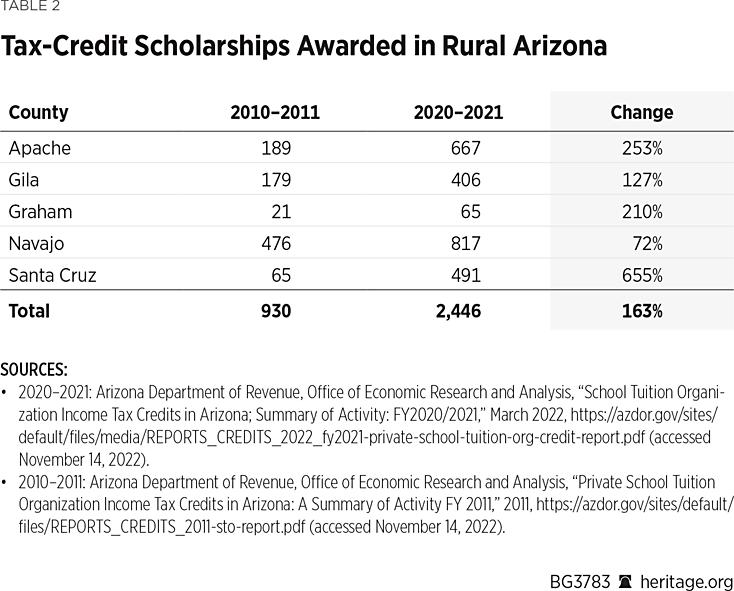
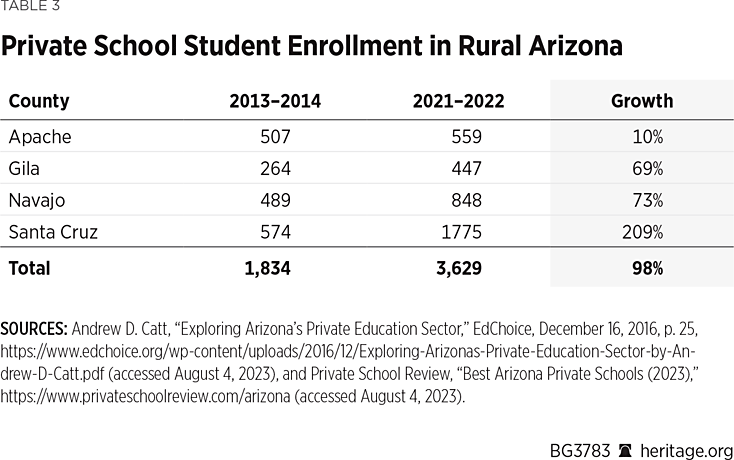
Arizona rural families and teachers have had the most access to both private school and charter school choice at a higher level and for a longer period than in any other state. Policymakers interested in how education choice policies affect rural areas would do well to study rural Arizona’s education system over the past two decades.
How Do Academic Trends Compare in Rural Texas and Rural Arizona?
Critics of school choice regularly predict that it will harm rural public schools. But the evidence shows otherwise.
There have been 28 empirical studies on the effects of education choice policies on the academic performance of students who remain at their traditional public schools.REF Of these, 25 find statistically significant positive effects on test scores, while only two find small negative effects and one finds no visible effect.REF Education choice is the rising tide that lifts all boats.
Nevertheless, some critics say that although education choice policies have a positive effect overall, it could still be the case that strongly positive effects in urban and suburban areas are masking negative effects in rural areas. David DeMatthews, a professor of education policy at the University of Texas at Austin, predicts that education choice policies will negatively affect rural district schools: “Because rural schools tend to be a lot smaller, the impact of vouchers—the impact of losing just a few students—could be so significant to a rural school that they couldn’t come back from.”REF
If that were true, rural Arizona would be littered with the remains of failed rural district schools, destroyed by the state’s robust and long-standing education choice policies. Districts should be closing their doors in rural Arizona and academic achievement in those districts should be in sharp decline.
But are Arizona’s rural school districts withering and dying because of school choice, as the critics predicted? Hardly. The National Center for Education Statistics listed 224 school districts in Arizona in 1993, the year before choice policy began. In 2019, the same source listed 226 Arizona school districts.REF The death of rural school districts facing school choice appears to have been greatly exaggerated.
Indeed, far from dying, Arizona’s rural district schools are thriving. Chart 3 shows the gains or losses on the NAEP’s math and reading assessments for rural fourth-grade and eighth-grade students in Arizona, Texas, and the United States overall between 2007 and 2019.
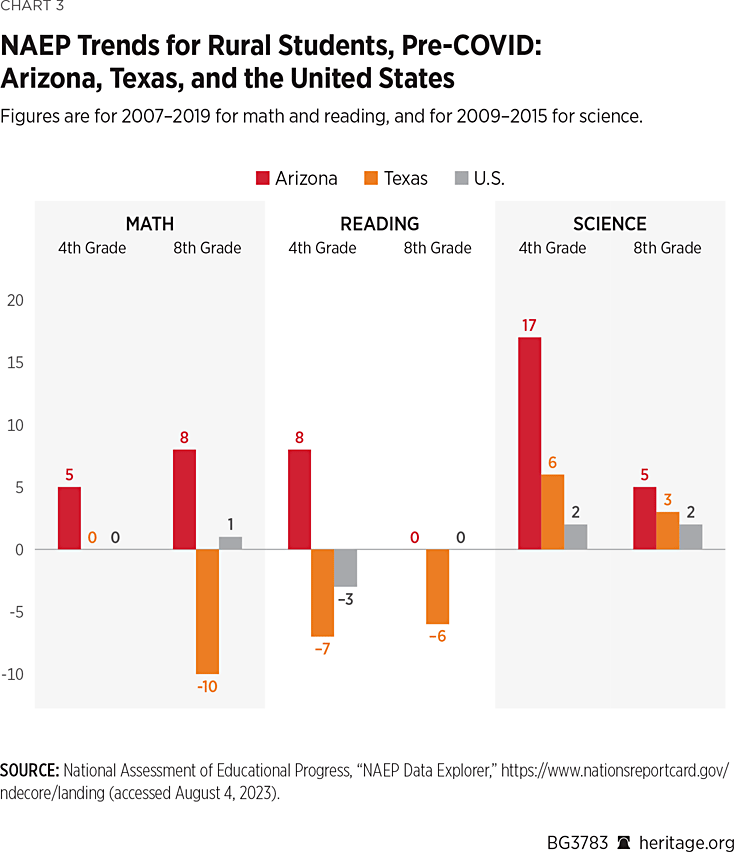
During the pre-COVID-19 era, Arizona’s rural students made academic progress, while rural students nationwide had flat achievement and rural Texas trended negative. The NAEP trends do not support the notion that choice is destructive to academic achievement in rural areas. In fact, it supports the opposite conclusion: The state with the most rural school choice has unusually large academic gains for rural students, compared to the national average. Inclusion of the 2022 (post-COVID-19) data in Chart 4 only reinforces this conclusion.
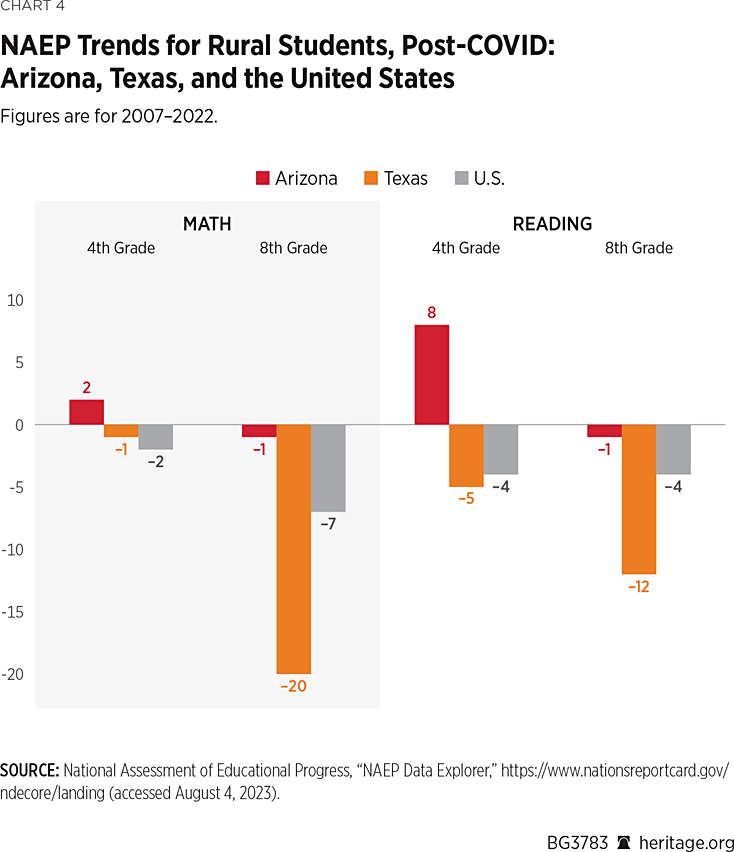
On the latest NAEP assessments, Arizona rural students showed the most positive trend nationwide on all six exams and the largest improvement on any of the six exams. Meanwhile, rural students in Texas suffered alarming declines on multiple exams. Given that 10 points is considered the equivalent of one grade level, the level of proficiency in math among today’s Texas eighth-graders is essentially two grade levels behind the eighth-grade cohort in 2007.
The Stanford Educational Opportunity Project has created a separate set of nationally comparable data. The NAEP data presented above shows cohort trend data for rural students—comparing rural Texas students in 2007 to rural Texas students in 2019. By linking testing data for grades three to eight across all 50 states, Stanford University scholars have measured academic growth by individual school district (including the charter schools operating within their boundaries, if any).
Education scholars widely regard academic growth as the most important measure of school quality. Unlike measures of academic achievement, which is highly correlated with student demographics, growth measures academic progress over time—where the students started and how much they learned.
Arizona’s K–12 students have shown tremendous growth. The Stanford Educational Opportunity Project found that, between 2008 and 2018, Arizona students had the highest overall level of academic growth in the nation. When disaggregating students by family income, Arizona’s students remained first in the nation for growth among both students from low-income families and those from middle-income and high-income families. As the Stanford Educational Opportunity Project explained, because “most educational opportunities in grades 3–8 are provided by schools, the average learning rate largely reflects school quality.”REF
Chart 5 presents the average rate of academic growth for rural school districts and charter schools in Arizona and in Texas.
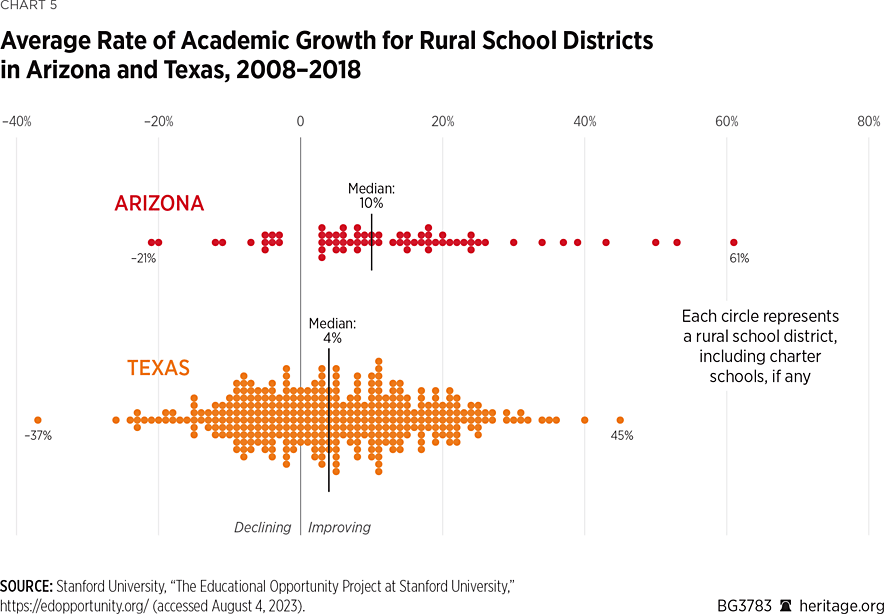
Each dot in Chart 5 represents a rural school district (including the charter schools operating within the boundaries of the district, if applicable). School districts that made the equivalent of one year of academic progress on the NAEP from 2008 to 2018, on average, fall on the “zero percent” line. Dots above that line represent school districts that made more than the equivalent of one year of academic progress, on average, while dots below the line represent school districts that averaged less than one year of progress annually during the decade.
A small percentage of Arizona rural districts failed to achieve the equivalent of one year of progress, and the slope of the Arizona line is much steeper than that in Texas. Between 2008 and 2018, students in rural Arizona public schools learned at a rate approximately twice as fast as rural public students in Texas.
The evidence is clear: Education choice is benefiting, not harming, students in rural Arizona.
Choice for Families Means Choice for Teachers, Too
Education choice policies provide families with more education options because they foster an environment in which teachers and education entrepreneurs can open their own schools and teach according to their own vision of a high-quality education. What the data above do not capture are the real-life stories of teachers in rural Arizona who are doing just that. Below are three examples of teachers in rural Arizona who founded their own schools and served students through private choice programs.
Hadassah John grew up on the Apache Reservation in rural eastern Arizona and attended Apache reservation schools. She became inspired to start a new school because public schools in the area were low-performing, and her students experienced bullying and a lack of academic challenge. The local school district spends well above the Arizona state average but earned a letter grade of “F” on the state’s annual achievement profile. Parent reviews, and even a teacher review, on the Great Schools website were scathing. John felt that the community needed an alternative, so she created one. Quoting Albert Einstein, John noted, “It is the supreme art of the teacher to awaken joy in creative expression and knowledge.”REF Like other microschools that are part of the Prenda network, John’s school generally served five to 10 students at a time. The instructional methodology employed a combination of distance learning and project-based learning.
Lara DeRoule taught in the largest school district in Arizona for many years before burning out of the profession. Endless test prep and teaching from a script left Lara unfulfilled. “It just was a bunch of testing at that time where I felt like we weren’t really using what we found out,” she explained.REF DeRoule returned to education by founding her own small school on an Arizona farm. Roughly a dozen students tend to the needs of chickens, goats, tortoises, and donkeys in addition to more traditional academics. Even as despair and depression gripped American students during the pandemic these students were engaged in a joyous and active education.
When Laurie Cosper of Snowflake, Arizona (population 7,000), asked her pastor why the church did not have a school, he told her to start one. Calvary Chapel Christian Academy Snowflake will open in the fall of 2023 with a science, technology, engineering, arts, and mathematics (STEAM) project-based learning curriculum and at least 11 students—with plans to grow. “We can all see what’s happening in public schools with the critical race theory and the weirdness they’re doing with sex education, all the way down to kindergarten,” Cosper told an interviewer. “There are just highly inappropriate things happening in public schools, and they’re disguising it as social emotional health.”REF
Rural Texas does not lack educators who could do amazing things in their communities. The educators simply lack the policies that will unlock their ability to collaborate with parents and students. By enacting a K–12 ESA policy, Texas lawmakers could usher in a new era of education freedom for students and teachers.
Rural Texas Needs K–12 Choice
Rural students in Arizona enjoy far more education choice options than rural students in any other state. Far from harming schools in rural areas, education flourished in rural areas under Arizona’s robust choice environment, just as much as in the remainder of the state. Arizona’s rural schools not only did not crumble, but they also diversified their offerings, and their academic performance grew stronger over time. The data could not be clearer: Rural students with expanded opportunities thrive.
This fact is about far more than data trends: It is about students, teachers, and communities improving their lives and their futures. A one-size-fits-all education system in fact fits few students and teachers, whereas a pluralistic and diverse system of schools fits more students and teachers.
One-size-fits-few education does not work in rural communities, or anywhere else. Some choice opponents will claim that Texas lawmakers should “protect” rural communities from teachers like Hadassah John, Lara DeRoule, and Laurie Cosper. Such a notion is deeply misguided. Giving teachers the opportunity to create their own schools will prove especially beneficial to rural Texas communities. Texas lawmakers can give teachers the opportunity to create their own schools to fulfill their vision of a high-quality school. Teachers in rural Arizona have seized the opportunity to run their own schools. Rural Texas communities can and should enjoy the same opportunity.
When families have many options to choose from, district schools will have a strong incentive to improve. If Texas lawmakers empower their educators to create new schools, educators will rise to the challenge, both inside and outside the traditional school system.
Matthew Ladner, PhD, is Senior Advisor for Education Policy Implementation in the Center for Education Policy at The Heritage Foundation. Jason Bedrick is Research Fellow in the Center for Education Policy.




